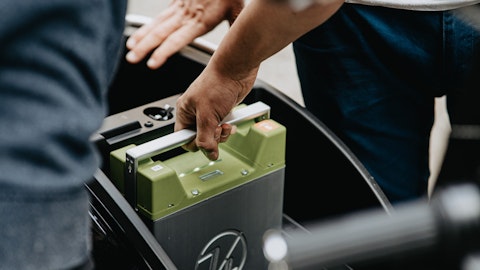John Van Scoter: Yes. The reception has been just what we hoped it would be. I think once you plant your flag and start to invest in a country like that, it’s really our first global expansion, people take notice. And so yes, we are getting differential treatment from the various partners and providers, suppliers over there and also very close collaboration with the national labs. They have clearly acknowledged that being there makes a difference. And we have hired now 3 nationals already throughout program management, technical lead as well as HR over there to build out that core team. So the reception is exactly what we had hoped, maybe a little bit better than that I had expected on the government side but it’s really coming in nicely.
Operator: Our next question comes from Jeffrey Campbell with Seaport Research Partners.
Jeffrey Campbell: Congratulations on all the success that you’ve laid out. I really only have one question at this point. And that is all these various samplings of the electrolyte and where the electrolyte is going, is it — is this electrolyte being tested for any other kind of battery architecture besides the silicon EV cell? Or conversely, if not, can we see this as some sort of validation of the silicon EV cell architecture?
John Van Scoter: Yes. Good question, Jeffrey. We believe that it’s being used in a variety of different anode-cathode combinations at this point. For obvious reasons, these OEMs generally keep those designs pretty close to their chest. So we don’t have a lot of visibility but we get some clues, if you will, based on what they’re asking for in terms of the changes to electrolyte. And I think it’s fair to say that there’s a number of different combinations of anode and cathode that are being utilized with our electrolyte at this point. Again, it underscores the — we’re really indifferent to the anode technology and the cathode technology. It speaks to the versatility, I think, of our electrolyte and of our business model. We do, again, work closely with the customers but don’t have ultimate visibility right now on those designs.
Operator: [Operator Instructions] Our next question comes from Vincent Anderson with Stifel.
Vincent Anderson: So just two quick ones on the SK partnership. Could you remind me, are you able to immediately start iterating off of your most recent A-2 battery with SK? Or does the nature of the JDA mean that you kind of have to start a few steps back and develop forward from there?
John Van Scoter: We will start with the A-1 design as a baseline because it’s the most learned and then build from there. But our intention would be to have ongoing collaboration for the various designs as we go forward. They’ve expressed the desire to do that same thing but it will start off of our base which we built largely last year.
Vincent Anderson: Okay. All right. That makes sense. And are they going to be explicitly sourcing raw materials for you or having a direct say in raw material sourcing?
John Van Scoter: You mean for our precursors or do you mean for the other components in the battery? In the battery?
Vincent Anderson: Yes, sorry. Apologies, yes, for your precursors.
John Van Scoter: No. We solely control our precursor vendors and selection.
Vincent Anderson: All right. And just shifting gears. I’m curious, are you planning on requiring or dedicating additional prototyping equipment or electrolyte manufacturing equipment to support the new electrolyte chemistry? And I’m only asking because I assume you’ve already started working on some of this R&D around the new chemistry and you feel the need to afford it its own lab space. So I’m just wondering if that’s going to eventually come with maybe entirely segregated lines and things like that.
John Van Scoter: We have the DVPR line that will be coming on midyear here. Well, lab, excuse me, not line. That will advance the state of the art there, advance our production capability in terms of continuous flow versus batch as well as driving on our cost vectors. But once that’s done, it’s designed so that whatever results can be seamlessly integrated into our SP2 existing powder line. And one of the, I think, real highlights of this year has been the flexibility that, that line has demonstrated already. I mean it was designed for flexibility. But as we’ve gone through these customer sampling exercises I described previously, our ability to actually tune it very quickly to the customer requirements is really proven to be beyond even my expectations. So we don’t envision a different line other than the DVPR lab that then will — that material designs will migrate into the standard SP2 facility.
Operator: This concludes our question-and-answer session. I would like to turn the conference back over to John Van Scoter for any closing remarks.
John Van Scoter: Thank you for joining the call today everyone and for your interest in Solid Power. We look forward to updating you again next quarter.
Operator: The conference has now concluded. Thank you for attending today’s presentation. You may now disconnect.
Follow Solid Power Inc. (NASDAQ:SLDP)
Follow Solid Power Inc. (NASDAQ:SLDP)
Receive real-time insider trading and news alerts




